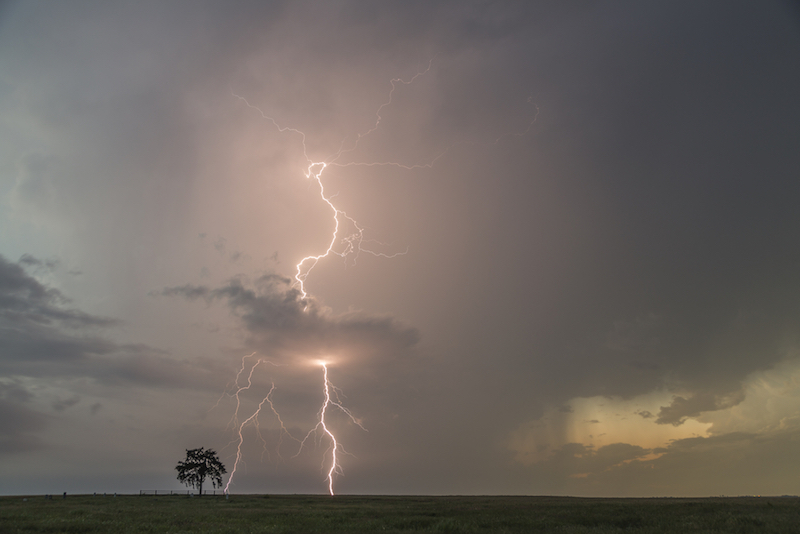Why Lightning Deaths Are Up This Year

Lightning has already killed as many people in the U.S. this year as in all of 2015, according to the National Weather Service (NWS).
Although it's not clear what's driving all these deaths, it's a good bet that people are taking more risks than usual, according to an expert at the NWS.
"One of the biggest problems is that people don't like to be inconvenienced by thunderstorms," said John Jensenius, an NWS lightning safety specialist. "They have plans, they want to go through with those plans, and they're willing to take the chance. And unfortunately, some people are killed or injured because they do take a chance." [Images of Lightning Unfolding, Frame by Frame]
The latest fatality happened in Carbon County, Pennsylvania, when lightning killed a 38-year-old man who was swimming in a state park during a storm on Saturday (Aug. 13), according to The Morning Call, a local newspaper.
The man's death brought the number of 2016 lightning fatalities in the U.S. to 27, Jensenius said. That's more than the average number of lightning-related deaths for the past 10 years through Aug. 13, which is 25, he said.
Like the 38-year-old-man, most lightning fatalities in the country occur when people are doing leisure activities, Jensenius said. For instance, the first person killed by lightning in the U.S. in 2016 was a 28-year-old woman who died in March in her tent at a music festival in Louisiana, he said.
Other 2016 lightning fatalities included people at family picnics, working in their yards, riding horses or simply standing outside with friends, Jensenius said. Earlier this month, lightning killed a 5-year-old boy when his family was visiting a beach in North Carolina, Live Science reported.
Get the world’s most fascinating discoveries delivered straight to your inbox.
So far, most lightning deaths in 2016 have occurred on the East Coast and in the South, including six fatalities in Florida, four in Louisiana, three in New York and two each in Mississippi, Alabama and North Carolina, Jensenius said.
Moreover, more men than women die from lightning strikes. This year, 22 (81 percent) of the deaths were men, Jensenius said. That's partly because men are more likely to work in outdoor jobs, such as construction. But it's also likely that more men die from lightning strikes because they tend to take more risks and may be less willing than women to get to a safe place during storms, Jensenius said.
He added that in addition to this year's 27 fatalities, a vast number of people have been injured by lightning strikes. For instance, lightning gravely injured a 29-year-old man when he was on his house deck in St. Augustine, Florida on May 17, according to a GoFundMe page raising money for his medical care.
Lightning safety
During a lightning storm, people should head inside or get into a hard-topped metal vehicle, Jensenius said.
"One of the worst things to do [during a storm] is shelter under a tree" during a storm, Jensenius told Live Science. That's because even though lightning may strike the tree, a "side flash" may occur, meaning that part of the current can jump from the tree to a person standing close by, according to the NWS. [What Are the Odds of Dying from Lightning?]
"Side flashes generally occur when the victim is within a foot or two [0.3 to 0.6 meters] of the object that is struck," the NWS said.
Safety advocates also offered another compelling reason to stay away from trees and other tall outdoor structures during a lightning storm. Once lightning strikes, its ground current can be lethal, the NWS said. "Because the ground current affects a much larger area than the other causes of lightning casualties, the ground current causes the most lightning deaths and injuries," including of farm animals, the NWS said.
There's not much variation in the number of lightning storms from year to year, so the uptick in deaths from lightning in 2016 can likely be explained by differences in human behavior, Jensenius said. However, educational campaigns and advances in lifesaving technology have saved countless lives, he said. In 1995, there were 85 deaths in the U.S., in 2000 there were 51 and in 2010 there were 29, according to the NWS.
"We think a lot of that had to do with education and awareness," Jensenius said.
Original article on Live Science.

Laura is the managing editor at Live Science. She also runs the archaeology section and the Life's Little Mysteries series. Her work has appeared in The New York Times, Scholastic, Popular Science and Spectrum, a site on autism research. She has won multiple awards from the Society of Professional Journalists and the Washington Newspaper Publishers Association for her reporting at a weekly newspaper near Seattle. Laura holds a bachelor's degree in English literature and psychology from Washington University in St. Louis and a master's degree in science writing from NYU.



